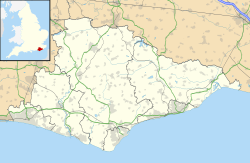Bethel Strict Baptist Chapel, Robertsbridge facts for kids
Quick facts for kids Bethel Strict Baptist Chapel |
|
|---|---|

The former chapel from the west
|
|
| 50°59′10″N 0°28′29″E / 50.9861°N 0.4748°E | |
| Location | High Street, Robertsbridge, East Sussex |
| Country | England |
| Denomination | Baptist |
| Churchmanship | Strict Baptist |
| History | |
| Status | Chapel |
| Founded | 1 November 1842 |
| Founder(s) | James Weller |
| Architecture | |
| Functional status | Closed |
| Heritage designation | Grade II |
| Designated | 13 May 1987 |
| Style | Vernacular |
| Groundbreaking | 1 November 1842 |
| Completed | 17 January 1843 |
| Closed | c. 1999 |
The Bethel Strict Baptist Chapel was once a special place of worship for a group called Strict Baptists in Robertsbridge, a village in East Sussex, England. This simple brick building, built in 1842, is partly hidden behind older buildings on the village's main street. It was started by a man named James Weller, whose powerful speeches attracted many people across Kent and East Sussex.
Strict Baptists were quite popular in East Sussex. Many people in Robertsbridge, far from the main Anglican church, chose to worship in different ways. The chapel closed around 1999 and was later changed into a house. It is now a Grade II listed building, which means it's an important historical site protected by English Heritage.
Contents
The Chapel's Story
Early Days of Robertsbridge
The village of Salehurst was first mentioned way back in 1086. Robertsbridge, about 1 mile (1.6 km) from Salehurst, didn't exist until after 1210. That's when a group of monks called Cistercians moved their abbey there. By the 1300s, Robertsbridge had grown much larger than Salehurst.
However, Robertsbridge didn't have its own official church. The main parish church was still in Salehurst. In 1676, a survey showed that Salehurst parish had many "Nonconformists." These were people who worshipped outside the official Church of England but were not Roman Catholic.
What are Strict Baptists?
Many different Christian groups, known as Nonconformists, grew in Sussex from the 1600s. Calvinistic groups were very popular, especially in East Sussex. These groups believed in predestination, which is the idea that God has already chosen who will be saved.
Strict Baptists are a type of Calvinistic group. They also believe that only people who have been baptized and become church members should take part in communion (a special religious meal).
James Weller's Journey
James Weller was a preacher who became very important to the Strict Baptist movement in the 1830s. He was born in Headcorn and worked as a farmer. Around 1828, he had a spiritual experience during an illness and decided to become a Calvinistic Baptist. He was re-baptized in 1831.
Weller became known for his preaching, attracting large crowds in Kent and East Sussex. In 1838, he came to Burwash, where another Strict Baptist chapel was located.
Building the Chapel
In 1842, James Weller decided to start his own chapel. A friend, James Caffyn, offered him a house on Robertsbridge High Street. This house could be turned into a place of worship.
The first stone for the chapel was laid on November 1, 1842. It was "half hidden behind a shop and a cottage." Weller officially left the Burwash chapel in January 1843. The Bethel Strict Baptist Chapel opened its doors on January 17, 1843. Weller said he preached to a very large group that day.
It was common in Sussex for chapels to be built for specific preachers. In its early years, many people who came to Bethel Chapel were from the Burwash congregation, not just Robertsbridge village.
Later Years and Closure
The Bethel Chapel officially became a church in August 1844. James Weller continued to face health and money problems, and he passed away in 1847.
George Stedman became the next pastor in 1848 and served until 1881. After Stedman, the chapel didn't have another full-time pastor, and its numbers slowly went down in the early 1900s.
However, the chapel saw a new burst of life starting in 1940. It was reorganized, and regular services began again. The chapel was even registered for marriages in August 1962. People were still meeting there in 1996. But in October 1999, permission was given to change the chapel into a house.
The Bethel Chapel was officially listed as a Grade II historic building by English Heritage on May 13, 1987.
Chapel Design
The Bethel Chapel is a great example of the simple and tasteful style often used by Strict Baptists. It looks quite different from the grander Congregational Church nearby, which was built later in 1881.
The chapel was built in 1842, and you can see this date carved into a stone tablet high up on the front wall. This front wall is made of red brick. It has two wooden windows with pointed tops. The sides of the building are covered with red tiles, and the roof has slate tiles. The main entrance is under a small, pointed roof.
Inside, there was a special stone tablet remembering James Weller, who died on September 12, 1847. It included a Bible quote: "Blessed are the dead who die in the Lord." Another stone remembered George Stedman, the second preacher, and Christopher Sharp, another person important to the chapel's early history. James Caffyn, who gave the land for the chapel, and his two daughters also had a memorial. His daughters had passed away when they were very young and were buried nearby.
See also




